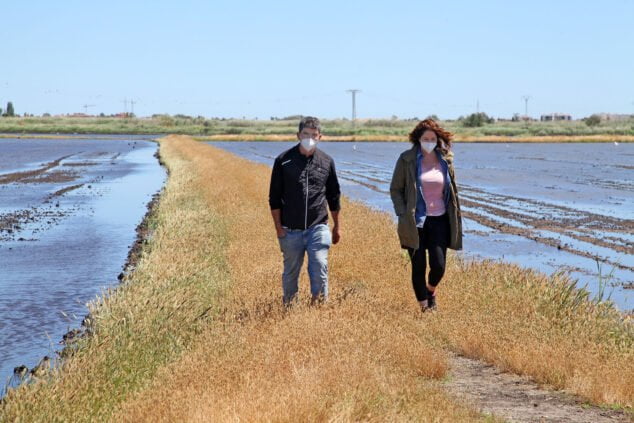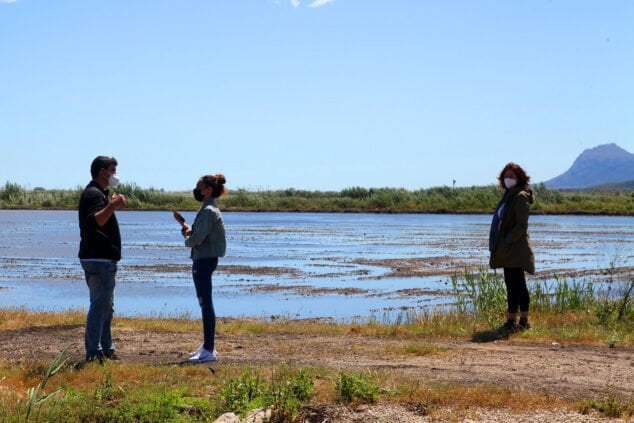An incomparable natural wealth, a unique variety of rice, a privileged environment ... Does that sound familiar to you? We are talking about the Marjal de Pego-Oliva, the sweet rice and the interior of the Marina Alta.
Chocolate rice: a variety born in Pego
We visit this regional paradise, together with Vicent and Paula Dominguis, managers of Pego Natura, a family business in which the products grown in the area are sold directly to the consumer. "In La Marjal we have joined small owners to make larger plots since the cultivation is highly mechanized." Total, 'els pegolins' They cultivate about 90 hectares, a considerable area where Bomba rice is produced and, the jewel in the crown, the chocolate rice.
The world-renowned Valencian Bomba rice will sound familiar to most, but what is the Bombón Rice? This historical variety of Pego was born here and after more than 50 years without being cultivated, it has returned - sure to stay - in La Marjal.
"El Bombón was born in Pego and had its fame in the 30s and 40s. At that time Pego had a good rice industry but the crop went into decline in the 70s and as it was the only place where it was grown, it was lost".
This variety of rice is the pride of the 'pegolins'. "It is an interesting variety because it has a lot of quality, it differentiates us from other areas, the great chefs like it a lot and, furthermore, as it is native, it adapts very well to our terrain".
70s: Decline and Walt Disney
La Marjal is enjoying one of its best times. Since in 1994 the Generalitat declared the area a Natural Park, the Marjal is booming and recovering. But there were complicated years, as the agricultural engineer, Vicent Dominguis, tells us, "in the 70s the Marjal was abandoned and that did us a lot of damage because they were more than 20 years without cultivating. And why was it abandoned? "The time of the 'boom' in construction and in the tourism sector came where much more money was earned than growing rice."
In those years of decadence, Back in 1985, the Marjal de Pego-Oliva was about to disappear permanently. More than 25 years ago, they knocked on the door of the 'pegolins' Walt Disney Productions technicians Billy Gair and Wing Chao.
Pego was one of the Mediterranean areas that the Walt Disney production company was considering to create its new amusement park. In fact, for the managers, this municipality of the Marina Alta was the preferred area in the Spanish territory because it shared many similarities with the other locations where there were Disney theme parks.
At that time, as we say, it had not yet been declared a Natural Park. That decision could have had a huge impact on the environment and on the richness of vegetation and animals in the area, in fact today it is part of the route of a large part of the birds that go from Western Europe to Africa.
Finally, it was decided that the first Eurodisney it would be located 30 kilometers from Paris, and ten years later the Marjal was totally protected from any real estate speculation.
The irrigation water is born here, in the Bullent river
But, let's continue in the Marjal. What is special and different about Marjal and its rice dishes? On the one hand, the earth, as you can see, is very dark and that is because it has a lot of organic matter and is naturally very fertile, ”explains Vicent. “And then, there is the quality of the waters, we irrigate with waters that are born here in the Bullent River. These waters infiltrate the valleys of the interior, where there are few inhabitants, there is little pollution and that translates into this product ”.
The rice producers of the Marjal have recently carried out a study on the bomba and bombón grain at the Miguel Hernández University of Elx. “The result has been spectacular”, the Dominguis brothers tell us. "It has been shown that the water we use is very clean and considering that the rice absorbs everything that the water carries, that makes us stand out as a rice production area."
Gone are the bad years. Now the Marjal de Pego-Oiva is recovering, thanks in large part to 'pegolins' such as Vicent and Paula who are dedicated to recovering its history and tradition, and making the production of this rice sustainable and viable, which does not intend to compete with that of the Albufera, but wants to continue making a place for itself as a different and unique product.
“This area is a luxury, the river is born here and 'els pegolins' We have to know how to sell our greatest assets ”, this is how the managers of Pego Natura say goodbye, assuring us that, although they do not know what will happen in the coming years," now we are cultivating a lot and, of course, we will fight so that our Marjal has a great future ".












